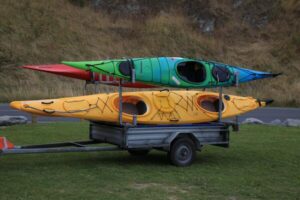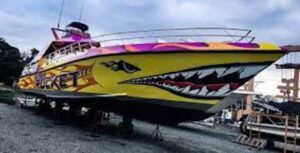One significant obstacle you must overcome now that you own a boat or are about to purchase that new toy is figuring out how to drive a boat safely. Here are some instructions on how to operate a boat for complete beginners. If you’d like to learn how to drive a boat, please read this article.
How To Drive A Boat
Although there are many different kinds of boats, this guide will primarily concentrate on those with a separate engine compartment.
This indicates that the engine is largely concealed from view in a compartment below deck or close to the stern, along with some of the boat controls and many other components.
Run The Blower
You must ensure that it is safe to launch a boat before you even consider doing so. If your boat has an engine compartment, it could be filled with gasoline vapor, which could be disastrous if lit by a starting engine.
Running your engine compartment blower should be your first action before doing anything else. Engine compartments must be ventilated with a blower.
The engine compartment will naturally have fumes and vapors because gasoline evaporates at a relatively low temperature.
Every boat with an engine compartment must be properly and adequately ventilated with a blower, according to USCG regulations. Your first step toward becoming a boat operator may be learning how to operate your blower, but it should be straightforward since most blowers are controlled by a toggle on the dash.
Once that has finished, spend some time going through your pre-departure checklist.

Start The Engine
What else is there to do but start the engine now that you’ve vented your engine compartment and gone through your pre-departure checklist several times? The likelihood of having a key ignition or a push-button ignition on a newer boat is probably 50/50, but they all basically perform the same functions.
Additionally, push-button engines typically still have a key; it just serves as an additional security measure.
- Kill Switch
In order to disable engine operation in the event of operator absence, almost every powered boat will have some type of kill switch on it. In order to keep the engine running, this safety feature must be kept activated.
The driver’s life jacket, vest, belt loop, or something similar is where a small clip is attached to keep this switch activated while the boat is being driven.
- Throttle Position
Normally, you won’t have to worry too much about the throttle position when learning to drive a boat, but it can be a potential reason why the engine won’t start when engaged.
The throttle needs to be neutral for the engine to start. This is done to prevent the engine from being in gear and under throttle load when it first starts.
Read: How To Clean Boat Engine After Salt Water?
Remove The Lines
There is one more task you must complete before you can actually depart after you have completed your pre-departure checklist, warmed up the engine, and believe you are ready to operate the boat. Your mooring lines will need to be cut.
Boats that are moored or docked are fastened to the dock with lines, whether it’s in a personal boat slip that you rent on a monthly basis at your local harbor or at a marina while you get lunch and fuel. These lines are fastened to dock cleats by wrapping them around them.
Start Moving
You are prepared to move and begin learning the fundamentals of driving once you and your vessel are released from the moorings. You might be able to simply pull forward and leave the dock area, depending on how you are docked.
In other circumstances, such as covered boat slips, you might need to back the boat out before moving forward.
Regardless of whether the engine is in forward or reverse, you must put it in gear before you can start the actual motion needed for motorboat operation.
Take hold of the throttle control, squeeze the button on the underside to start the engine, then move the throttle gently forward or backward until you hear the gear shift, then let go of the button.
Adjust The Throttle
Your first boat movement will be completed by adjusting the throttle as necessary. Learning how to properly adjust the throttle makes boat control much simpler because speed is essential for boat control.
Stepping on the gas is the equivalent of starting your car in neutral and moving the throttle handle forward to increase the amount of fuel/air mixture you give it.
In order to drive a boat safely and effectively, throttle control is crucial. A boat doesn’t have brakes, so slowing down is more difficult than simply lifting your foot off the accelerator like in a car.
You will need to ease off on the gas in order to slow down because the engine won’t just go back to idle on its own.
Steering A Boat
We made the point that using a steering wheel on a boat is very similar to using one in a car. The boat follows your wheel turns—most of the time.
Always keep in mind that other elements, such as the wind, waves, and current, can affect the direction in which a boat travels.
A turn of the wheel may not always cause the boat to move in the direction that was intended because of this. Boats may handle differently depending on the circumstances.
Docking, which many novice boaters cite as one of the trickiest maneuvers to learn, can be especially frustrating in this situation.
Slowing A Boat
Since boats lack brakes, there are a few additional things you should be aware of in order to slow one down. We already mentioned that you must adjust the throttle.
- You should first get to know your boat and discover how much stopping distance is required to stop completely and safely when traveling at various speeds.
- Keep in mind that boats are subject to much more motion than vehicles and lack seatbelts. People can become unbalanced or even fall overboard as a result of sudden or abrupt changes in speed or direction.
- Always be mindful of how you turn or change your speed. When performing quick maneuvers, it’s a good idea to shout out a warning to your passengers so they know to hold on if at all possible.
However, the following methods will slow a boat down the quickest:
- first pulling the throttle back to neutral;
- pausing for a moment;
- then shifting into reverse and applying some power.
Tips When Driving
- Always keep a keen awareness of your surroundings.
- Slow down when in doubt. Slow is pro!
- Never operate a boat while intoxicated.
- Shift into neutral for more precise handling when driving through narrow spaces to approach a dock or slip.
- To increase effectiveness and performance, properly trim a boat.
- Navigate at a 45-degree angle toward the wake of a large wave or wake.
- When on the plane, make slow and steady steering adjustments.
- Avoid making quick, abrupt throttle changes while flying.
- Before even leaving the dock, familiarize yourself with the “rules of the road.”
- Always consider the weather as well as elements of the outside environment, such as the wind, waves, and current.



